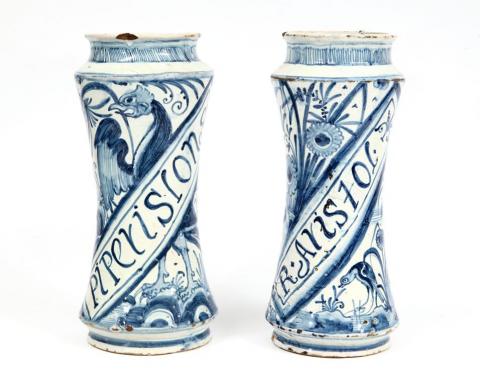Par de Mangas de Farmácia
A Pair of Apothecary Jars
Portuguese faience
Lisbon, 1620 - 1640
H.: 28.0 cm
Prov.: J.M.J. collection, Lisbon
Faiança portuguesa
Lisboa, 1620 – 1640
Alt.: 28.0 cm
Prov.: Coleção J.M.J., Lisboa
A pair of exceptional apothecary jars, dating from the first-half of the 17th century, featuring a mildly concave cylindrical body decorated in cobalt-blue pigment on a tin white enamel ground.
One of the jars is characterised by profuse decoration of exuberant landscape with rocky outcrops and exotic vegetation, from which emerge peonies and an open winged golden eagle, symbol of courage, strength and temerity. This landscape is interrupted by a rectangular oblique cartouche inscribed PIPERIS.LONG in Latin, referring to the Indian Long Pepper. This medicinal plant was prescribed to increase appetite, as well as in the treatment of stomach aches, heartburn, indigestion, bowl wind, diarrhoea and cholera. Associated to other plants was also used in Ayurvedic medicine.
On the other jar the decorative composition is structured in two superimposed sections: on the upper section an exuberant landscape with rocky outcrops and exotic vegetation from which stand out peonies, daisies, camellias and flying birds. The lower section repeats some of the decorative motifs, such as flowering camellias emerging from rock outcrops, as well as other foliage elements and long legged birds, probably royal cranes, symbols of wealth, longevity and heavenly guides. In this case the ornamentation is interrupted by an oblique band with the Latin inscription R. ARISTOL., referring to the root of Aristolochia indica, a medicinal plant recommended in the treatment of flus, as an expectorant, antitussive, antiasthmatic, antiseptic and anti-inflammatory.
On the shoulder of both jars identical bands of cobalt-blue oblique parallel lines, encased by double filleting.
It must be noted that the symbolic value of the iconography described above was most certainly not present in the Lisbon potter’s mind, who replicated it uniquely for its decorative value, ignoring its, most certainly unknown, allegoric interpretation. The magnificent monochrome decorative composition, developed over the white tin glaze surface, reveals the painter artist mastery in working the various pigment densities, which endow the composition with sophisticated pictorial movement and depth, while simultaneously highlighting the qualities of the glaze and of the fine clay. Worthy of note is also the fact that these jars have survived as a pair.
Par de magníficas mangas de farmácia de formato cilíndrico cintado, datadas da primeira metade do século XVII, com decoração a azul-cobalto sobre esmalte branco estanífero.
Uma das mangas caracteriza-se pela profusa decoração de exuberante paisagem com rochedos e vegetação exótica, onde se destacam peónias e uma águia-real de asas ainda abertas, símbolo de coragem, força e temeridade. Apresenta uma cartela retangular e oblíqua com a inscrição latina PIPERIS.LONG. que se refere à pimenta-longa indiana. Esta planta medicinal era receitada para aumentar o apetite, bem como no tratamento da dor de estômago, azia, indigestão, gases intestinais, diarreia e cólera. Associada a outras plantas era também usada na medicina Ayurvédica.
Na outra manga, a decoração estrutura-se em dois registos: no superior, uma exuberante paisagem com rochedos e vegetação exótica, de onde se destacam peónias, boninas, camélias e pássaros em pleno voo. No registo inferior, repetem-se alguns dos elementos decorativos, como camélias floridas emergindo de rochedos, bem como outros elementos vegetalistas e aves pernaltas, provavelmente garças-reais, símbolos de riqueza, longevidade e indicadoras do caminho para o céu. Nesta, a ornamentação está interrompida por uma cartela oblíqua com a inscrição em latim R. ARISTOL., correspondendo à raiz de aristolochia, que era receitada para o tratamento das gripes como expetorante, antitússico, antiasmático, antisséptico e anti-inflamatório.
No colo de ambas as mangas, uma cercadura idêntica de linhas oblíquas paralelas a azul-cobalto emoldurada por filetes duplos.
Convém referir que o valor simbólico da iconografia descrita não estaria presente na mente do oleiro de Lisboa, que a reproduziu pelo seu carácter decorativo, ignorando a sua, certamente desconhecida, interpretação alegórica. A magnífica composição decorativa monocromática desenvolvida sobre a superfície branca do vidrado estanífero revela a grande habilidade do artista pintor nas diversas densidades do pigmento, as quais dão movimento e profundidade à composição de grande requinte pictórico, destacando também simultaneamente as qualidades do vidrado e da argila fina. É ainda de realçar o facto de estas mangas se terem conservado como par.
- Arte Portuguesa e Europeia
- Azulejos e Faianças

